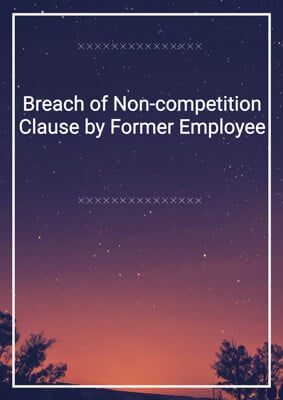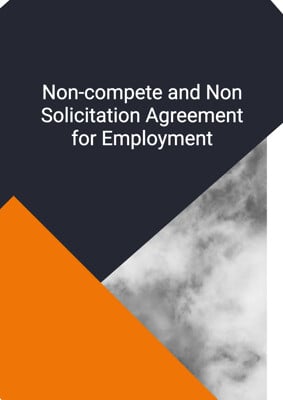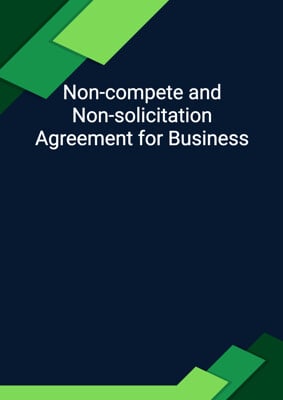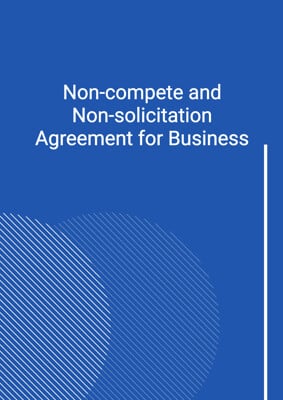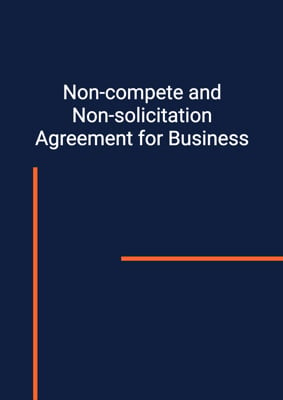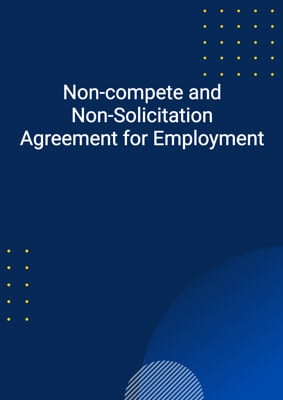
Non-compete and Non Solicitation Agreement for Employment
Employee
Looking for a simple and easy-to-understand one-way non-compete and non-solicitation agreement for employment? Our agreement is designed to benefit employees and includes unilateral obligations to prevent competition and solicitation.
How to Tailor the Document for Your Need?
01
Create Document
Fill in the details of the parties. You can click the "Fill with Member’s Information" button to complete it with information saved to your account.
02
Fill Information
Please fill in any additional information by following the step-by-step guide on the left hand side of the preview document and click the "Next" button.
03
Get Document
When you are done, click the "Get Document" button and you can download the document in Word or PDF format.
04
Review Document
Please get all parties to review the document carefully and make any final modifications to ensure that the details are correct before signing the document.
Document Preview
Document Description
The 'Non-compete and Non Solicitation Agreement for Employment' is a legal document that outlines the terms and conditions under which an employee agrees not to compete with or solicit from their employer, or its successors or assigns. The agreement is entered into between the employee (referred to as 'party 1') and the company (referred to as 'party 2').
The agreement begins with an interpretation section, which defines key terms used throughout the document. The term 'business' is defined as any and all business conducted by the company, either currently or in the future. The term 'compete' is defined as engaging in a business that is substantially similar to or directly or indirectly in competition with the present business of the company. The term 'solicit' is defined as inducing the company's customers, clients, directors, officers, employees, and consultants to terminate their relationship with the company or entering into another arrangement with a third party to circumvent the company.
The agreement then outlines the obligations of the employee regarding non-compete and non-solicitation. The employee agrees not to compete with the company's present business in a specific area, not to solicit any customers, clients, directors, officers, employees, and consultants from the company, and to keep confidential any trade secrets, business secrets, customer data, or confidential and proprietary information obtained from the company.
The document includes exceptions to the non-compete and non-solicitation obligations. The employee is allowed to make investments in quoted companies by acquiring or holding shares amounting to less than a certain percentage of the capital of a company quoted on any stock exchange and engaged in activities relating to the business. The employee is also allowed to acquire or hold shares in a company or other undertaking engaged in activities relating to the business if those activities contribute less than a certain percentage of that company's or undertaking's annual sales. Additionally, the employee is permitted to acquire or hold a controlling interest in a company or undertaking engaged in activities within the purpose, provided that the annual turnover of the competing activities in the purpose amounts to less than a specified currency amount.
The agreement includes acknowledgements from the employee, stating that they understand and acknowledge the fairness, reasonableness, and equity of the restrictions and provisions in the agreement. The employee also acknowledges that they have had the opportunity to obtain legal counsel to review the agreement.
The term of the agreement is specified, stating that the obligations under the agreement will terminate a certain number of months after the termination of employment with the company.
The enforceability of the agreement is addressed, stating that if any provision is found to be invalid or unenforceable, the remaining provisions will remain in full effect. The parties are allowed to come to an agreement and substitute the invalid provision with a similar enforceable term.
The agreement states that it does not grant any rights to third parties to enforce its terms under any law.
The governing law and jurisdiction are specified, indicating which jurisdiction's laws will govern the agreement and which courts will have jurisdiction over any disputes.
The agreement is declared to be the entire agreement between the company and the employee regarding the subject matter of the agreement.
Finally, the agreement is deemed legal and binding between the parties, with each party representing that they have the authority and capacity to enter into the agreement. The document is signed by the duly authorized representatives of both parties.
If there is a schedule attached to the agreement, it will be included at the end of the document.
How to use this document?
1. Enter the current date and the names of the employee and the company in the agreement, along with their principal places of business. This ensures that both parties are clearly identified.
2. Review the interpretation section of the agreement, which defines key terms used throughout the document. Understand the definitions of 'business,' 'compete,' and 'solicit' to have a clear understanding of the obligations outlined in the agreement.
3. Familiarize yourself with the obligations of non-compete and non-solicitation outlined in the agreement. Understand that the employee is agreeing not to compete with the company's present business in a specific area, not to solicit any customers, clients, directors, officers, employees, and consultants from the company, and to keep confidential any trade secrets, business secrets, customer data, or confidential and proprietary information obtained from the company.
4. Take note of the exceptions to the non-compete and non-solicitation obligations. Understand that the employee is allowed to make investments in quoted companies, acquire or hold shares in a company with less than a certain percentage of competing business, and acquire or hold a controlling interest in a company not predominantly engaged in competing business, as long as certain conditions are met.
5. Read and acknowledge the employee acknowledgements section of the agreement. Understand that the employee acknowledges the fairness, reasonableness, and equity of the restrictions and provisions in the agreement, and that they have had the opportunity to obtain legal counsel to review the agreement.
6. Note the term of the agreement, which specifies when the obligations under the agreement will terminate after the termination of employment with the company.
7. Understand the enforceability of the agreement. If any provision is found to be invalid or unenforceable, the remaining provisions will remain in full effect. The parties may come to an agreement and substitute the invalid provision with a similar enforceable term.
8. Be aware that the agreement does not grant any rights to third parties to enforce its terms under any law.
9. Take note of the governing law and jurisdiction specified in the agreement. Understand which jurisdiction's laws will govern the agreement and which courts will have jurisdiction over any disputes.
10. Understand that the agreement is the entire agreement between the company and the employee regarding the subject matter of the agreement. Both parties represent that they have the authority and capacity to enter into the agreement. Ensure that the agreement is signed by the duly authorized representatives of both parties.
Note: This guidance is provided for informational purposes only and does not constitute legal advice. It is recommended to consult with legal professionals for specific guidance related to the agreement and its implications.
Not the right document?
Don’t worry, we have thousands of documents for you to choose from:

